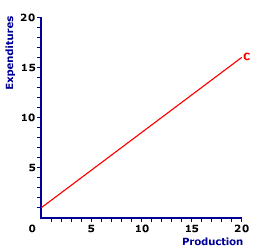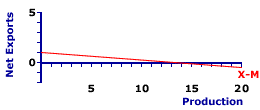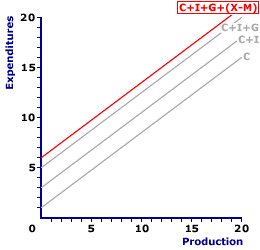
|
|
BANK FAILURE: In principle, this results when a bank's liabilities exceed assets for an extended period and the bank is forced to go out of business. This is comparable to other types of business that go bankrupt. However, because banks are heavily regulated by government entities, including the Federal Reserve System, Federal Deposit Insurance Corporation, and Comptroller of the Currency, bank failure does not necessarily mean that the bank ceases to operated. In may cases, such a failure means the operation of the bank is take over by one of the government entities. The troubled bank might also be allowed or "encouraged" to merge with another, healthier bank.
Visit the GLOSS*arama
|
|


|

|
                           FOUR-SECTOR AGGREGATE EXPENDITURES LINE: A graphical depiction of the relation between aggregate expenditures by the four macroeconomic sectors (household, business, government, and foreign) and the level of aggregate income or production. The four-sector aggregate expenditures line combines consumption expenditures, investment expenditures, government purchases, and net exports. The slope of this aggregate expenditures line is based on the marginal propensity to consume, adjusted for marginal propensities of the other expenditures that are assumed to be induced when constructing the line. This is one of three aggregate expenditures lines based on the number of sectors included. The others are the two-sector aggregate expenditures line and the three-sector aggregate expenditures line. The aggregate expenditures line, which embodies the key Keynesian principle of effective demand, shows the relation between aggregate expenditures and the actual level of aggregate income or production in the domestic economy. The income and production measures commonly used are national income and gross domestic product. A four-sector aggregate expenditures line combines the expenditures of all four macroeconomic sectors--household sector, business sector, government sector, and foreign sector.The four-sector aggregate expenditures line forms the foundation of the complete four-sector Keynesian model. The four-sector Keynesian model combines the four-sector aggregate expenditures line with the 45-degree line to determine the equilibrium level of income and production. The four-sector Keynesian model is the complete model containing all four macroeconomic sectors. It contains all ingredients of Keynesian economics. Consumption expenditures contain the basic induce expenditure relation through the marginal propensity to consume that is so important to Keynesian economics. Autonomous investment expenditures provide the primary source of business-cycle instability. Government purchases then offer the key Keynesian fiscal policy tool for addressing business cycle problems. And any interaction with the foreign sector through exports and imports. This four-sector aggregate expenditures line is commonly designated with a symbolic equation representing the four expenditures included in the line. where: AE is aggregate expenditures, C is consumption expenditures, I is investment expenditures, G is government purchases, and X-M is net exports, exports (X) minus imports (M).Four SectorsA good place to begin with the four-sector aggregate expenditures line is the four sectors that provide expenditures included in the line. These are the four macroeconomic sectors, the only four macroeconomic sectors--household sector, business sector, government sector, and foreign sector.- Household Sector: This sector includes the entire, wants-and-needs-satisfying, eating, breathing, consuming population of the economy. In a word, it includes everyone, all consumers, all people, and every member of society. Pollyanna Pumpernickel, a hypothetical hardworking mother of two, is a representative member of the household sector. So too is Winston Smythe Kennsington III, a hypothetical affluent corporate executive.
- Business Sector: This sector contains the private, profit-seeking firms in the economy that combine scarce resources into the production of wants-and-needs satisfying goods and services. It includes proprietorships, partnerships, and corporations. OmniConglomerate, Inc., a hypothetical multi-billion dollar, multi-national, mega corporation, exemplifies a member of the business sector. However, Manny Mustard, a hypothetical proprietor who owns and operates a little sandwich shop is also part of the business sector.
- Government Sector: This sector includes all government entities that impose resource allocation decisions, that might not be made otherwise, on the rest of the economy. It consists of the three primary levels of federal, state, and local government responsible for passing and enforcing laws. Of course, all branches and agencies of the U.S. Federal Government--Congress, Department of Transportation, Environmental Protection Agency, etc.--is part of the government sector. So too is the hypothetical Shady Valley City Council and the hypothetical local Shady Valley Board of Education included in the government sector.
- Foreign Sector: This sector is comprised of everyone and everything outside the political boundaries of the domestic economy. It includes households, businesses, and governments in other countries. The foreign sector of the domestic United States economy includes the governments of other nations such as the hypothetical Republic of Northwest Queoldiolia. It also includes citizens and businesses in other nations, such as Horst Duncanstein, a hypothetical citizen of Northwest Queoldiolia, and Quedoldiolian Sundial Company, also hypothetically located in Northwest Queoldiolia.
Four ExpendituresThe aggregate expenditures line is the combination of expenditures by the four macroeconomic sectors--household, business, government, and foreign. Each of these four sectors is responsible for a specific expenditure on gross domestic product--consumption, investment, government purchases, and net exports. And each expenditure is represented by a corresponding expenditure line.| Consumption Line |  | Investment Line |  | Government Purchases Line |  | Net Exports Line |  |
The exhibit to the right presents the linear relations for each of the four aggregate expenditures.- Consumption Expenditures: The largest of the four expenditures on gross domestic product is consumption expenditures by the household sector. These expenditures are used to purchase everything from apple juice to cubic zirconium, essentially all of the goods and services that people purchase to satisfy wants and needs. The consumption line is the relation between these consumption expenditures and aggregate income or production. A representative consumption line, labeled C, is presented in the top panel of the exhibit to the right. This red line is positively sloped due to the Keynesian psychological law and the slope is measured by the marginal propensity to consume (MPC). The intercept is autonomous consumption.
- Investment Expenditures: The least stable of the four expenditures on gross domestic product is investment expenditures by the business sector. These are expenditures on capital goods, ranging from million-dollar factories to fifty-cent screw drivers. Investment expenditures are for fixed structures, equipment, and inventories (working capital). The relation between investment expenditures and aggregate income or production is illustrated by an investment line. Two alternative investment lines are presented in the second panel of the exhibit to the right. The horizontal gray line, labeled I, indicates autonomous investment, investment that is unaffected by income or production. The positively-sloped red line, labeled I', is induced investment, investment that is affected by income or production, and is measured by the marginal propensity to invest (MPI).
- Government Purchases: A key fiscal policy tool used to stabilize business cycles is government purchases on gross domestic product by the government sector. These are expenditures on goods and services used for a wide range of government activities, ranging from military aircraft to paper clips, and includes expenditures by federal, state, and local governments. It includes both capital goods as well as consumption goods. The relation between government purchases and aggregate income or production is illustrated by a government purchases line. Two alternative government purchases lines are presented in the third panel of the exhibit to the right. The horizontal gray line, labeled G, indicates autonomous government purchases, government purchases that are unaffected by income or production. The positively-sloped red line, labeled G', is induced government purchases, government purchases that are affected by income or production, and is measured by the marginal propensity for government purchases (MPG).
- Net Exports: The smallest of the four expenditures on gross domestic product are net exports by the foreign sector. Net exports are the difference between exports, domestic production purchased by the foreign sector, and imports, foreign production purchased by the three domestic sectors (household, business, and government). The relation between net exports and aggregate income or production is illustrated by the net exports line. A typical net exports lines is show in the bottom panel of the exhibit to the right. This negatively-sloped red line, labeled X-M, is the combination of autonomous exports and induced imports. Because imports are subtracted from exports, the negative slope of the net exports line is the negative of the marginal propensity to import (MPM).
The Four-Sector LineFour-Sector
Aggregate Expenditures Line |  |
A representative four-sector aggregate expenditures line is presented in the exhibit to the right. This red line, labeled C+I+G+(X-M) in the exhibit is positively sloped, indicating that greater levels of income and production generate greater aggregate expenditures by the four macroeconomic sectors. This positive relation reflects the Keynesian economics principle of effective demand--more income means more expenditures.Also included in this exhibit are three gray lines, labeled C, C+I, and C+I+G. These three lines represent the sequential stacking of expenditures by the four sectors, beginning with consumption (C), then adding investment (C+I), then adding government purchases (C+I+G), and finally ending with the complete four-sector aggregate expenditures line, C+I+G+(X-M). This particular four-sector aggregate expenditures line assumes that all expenditures, other than consumption, are completely autonomous. This is why all four lines in the exhibit are parallel. The C+I line is parallel to the C line because investment is autonomous and constant at all levels of income and production. The same can be said about the C+I+G and the C+I lines with respect to autonomous government purchases. Autonomous net exports then produce parallel C+I+G+(X-M) and C+I+G lines. Because consumption is the only induced expenditure, which is measured by the marginal propensity to consume, the slopes of all four parallel lines are also equal to the marginal propensity to consume. If any of the expenditures are assumed to be induced, then the slopes of the lines will change accordingly, becoming steeper if induced investment or government purchases are included and flatter if induced net exports are included. Two More LinesThe aggregate expenditures line actually comes in several varieties, depending on how many of the four expenditures are included and whether or not the expenditures are assumed to be induced or autonomous. The three most common aggregate expenditures lines represent the sequential inclusion of the four expenditures, beginning with consumption expenditures and investment expenditures, then adding government purchases and net exports.- Two Sectors: The simplest aggregate expenditures line is based on expenditures by the two "private" sectors--household and business. This two-sector aggregate expenditures line is the combination of consumption expenditures and investment expenditures. More often than not, this line is based on autonomous investment. This two-sector line captures the essential elements of Keynesian economics and thus is often used as an introductory presentation. One important element captured in this line is, first and foremost, induced consumption and the psychological law. Another element is the equilibrium equality between production and expenditures and the potential instability created by changes in autonomous investment.
- Three Sectors: A second expenditures line is obtained by adding the "public" or government sector to the two-sector line. This three-sector aggregate expenditures line is the combination of consumption expenditures, investment expenditures, and government purchases. In addition, an adjustment of consumption expenditures for taxes is also commonly incorporated in this line. This expanded line is not only more realistic, it also enables the analysis of the impact of government fiscal policies on the economy, which is a key consideration of Keynesian economics. The three-sector aggregate expenditures may or may not include induced investment, induced government purchases, or induced taxes.

Recommended Citation:FOUR-SECTOR AGGREGATE EXPENDITURES LINE, AmosWEB Encyclonomic WEB*pedia, http://www.AmosWEB.com, AmosWEB LLC, 2000-2024. [Accessed: July 26, 2024].
Check Out These Related Terms... | | | | | | | | | |
Or For A Little Background... | | | | | | | | | | | | | | | | | | | | |
And For Further Study... | | | | | | | | | | | | | |
Search Again?
Back to the WEB*pedia
|



|

|
BROWN PRAGMATOX
[What's This?]
Today, you are likely to spend a great deal of time at the confiscated property police auction trying to buy either a birthday greeting card for your grandmother or a coffee cup commemorating yesterday. Be on the lookout for telephone calls from former employers.
Your Complete Scope
This isn't me! What am I?
|

|
|
A thousand years before metal coins were developed, clay tablet "checks" were used as money by the Babylonians.
|

|
|
"Old age isn't so bad when you consider the alternative. " -- Cato, Roman orator
|

|
I
Income
|

|
|
Tell us what you think about AmosWEB. Like what you see? Have suggestions for improvements? Let us know. Click the User Feedback link.
User Feedback
|


|


